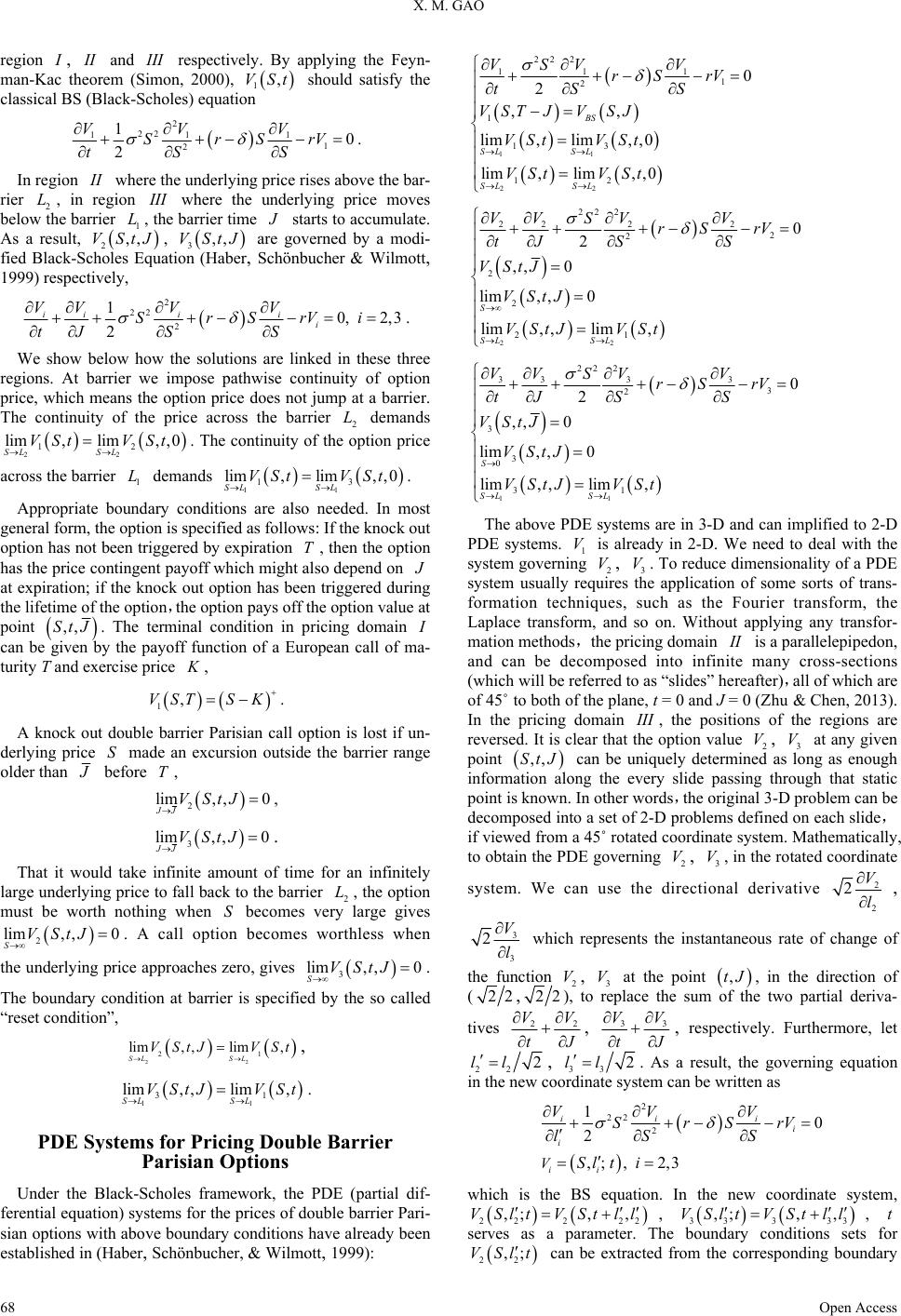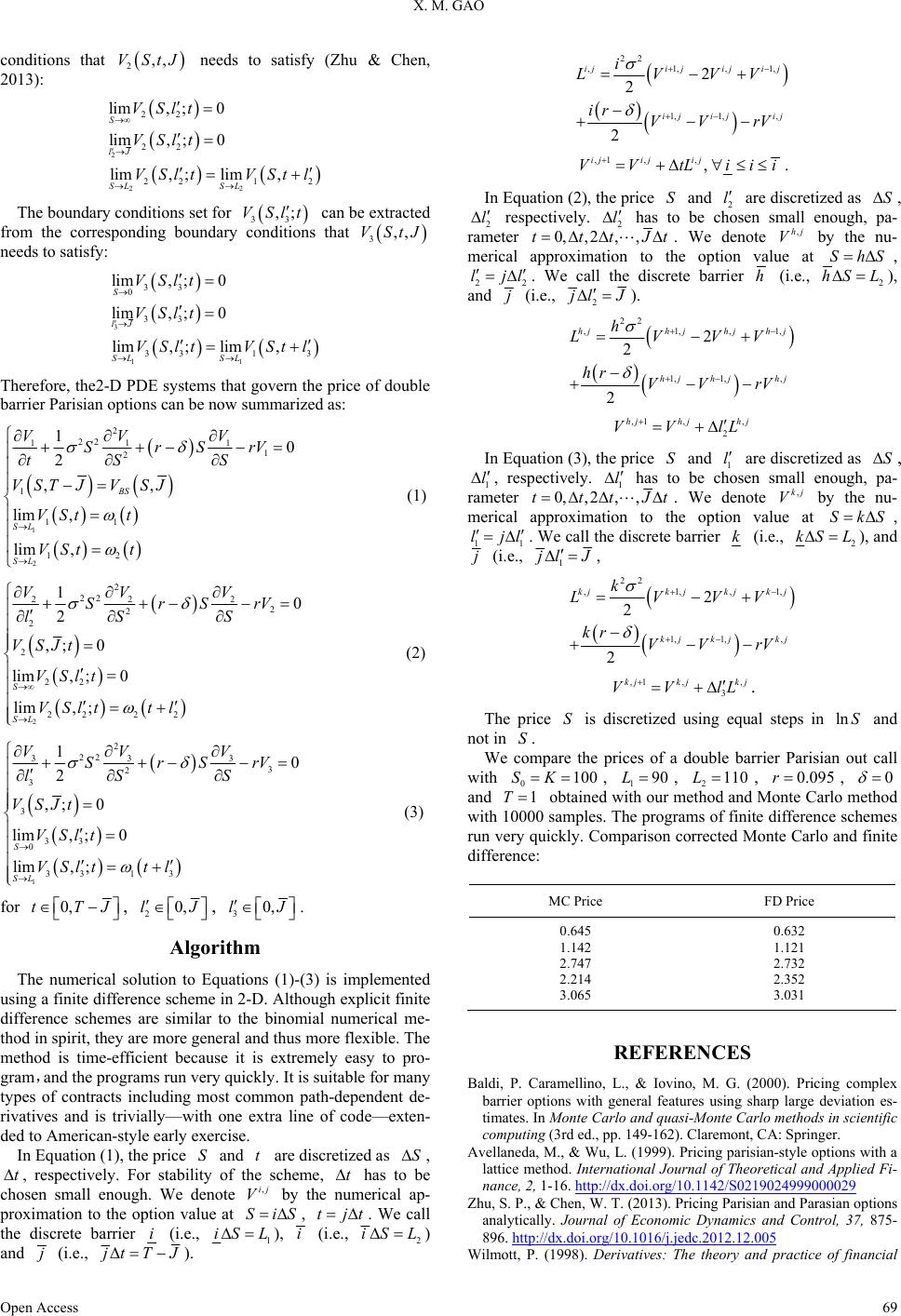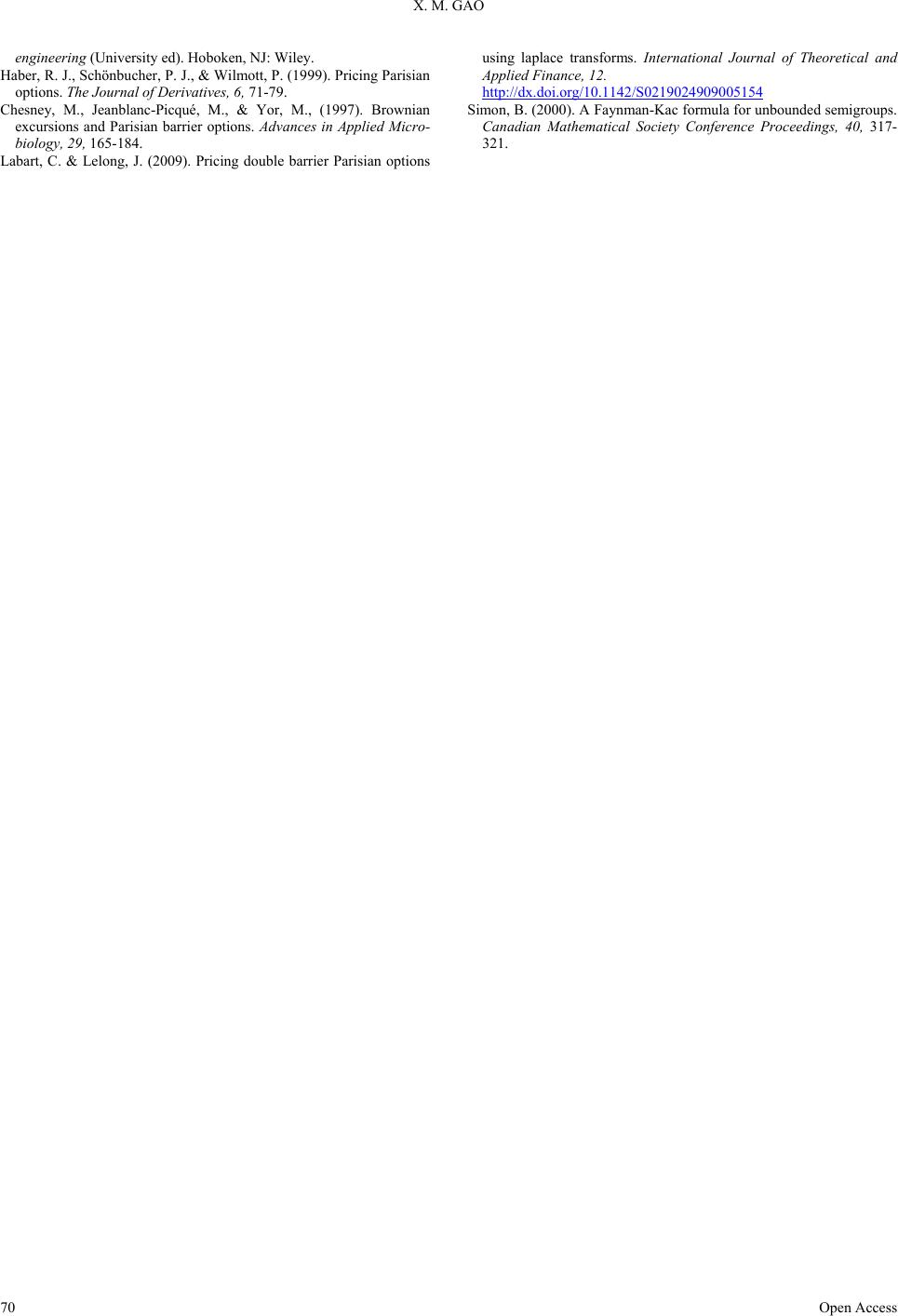 Journal of Financial Risk Management 2013. Vol.2, No.4, 67-70 Published Online December 2013 in SciRes (http://www.scirp.org/journal/jfrm) http://dx.doi.org/10.4236/jfrm.2013.24011 Open Access 67 Pricing Double Barrier Parisian Option Using Finite Difference Xuemei Gao South Western University of Finance and Econom i cs, Chengdu, China Email: gaoxuemei2000@sina.com Received September 15th, 2013; revised October 15th, 2013; accepted October 23rd, 2013 Copyright © 2013 Xuemei Gao. This is an open access article distributed under the Creative Commons Attribu- tion License, which permits unrestricted use, distri b ut io n, and reproduction in any medium, provided the original work is properly cited. In this paper, we price the valuation of double barrier Parisian options, under the Black-Scholes frame- work. The approach is based on fundamental partial differential equations. We reduce the dimension of partial differential equations,then using finite difference scheme to solve the partial differential equations. Keywords: Black-Scholes Model; Double Barrier; Parisian Options; Finite Difference Scheme Introduction It is well known that valuation of financial derivatives, such as options, is one of the major topics in quantitative finance research. A Parisian option is a special kind of barrier options for which the knock-in or knock-out feature is only activated if the underlying price remains continually in breach of the barrier for a pre-specified time period. The valuation of Parisian op- tions can be done by using several different methods: Monte Carlo simulations (Baldi, Caramellino, & Iovino, 2000), lattices (Avellaneda & Wu, 1999), Laplace transforms (Zhu & Chen, 2013) or partial differential equations. An approach based on partial differential equations has been developed by (Wilmott, 1998; Haber, Schönbucher, & Wilmott, 1999). The options we study in this paper are called double barrier Parisian options. The paper (Chesney, Jeanblanc-Picqué, & Yor, 1997) intro- duced the standard Parisian options with two barriers. Double barrier Parisian options are options where the conditions im- posed on the assets involve the time spent out of the range de- fined by two barriers. Double barrier Parisian options have already been priced by (Baldi, Caramellino, & Iovino, 2000) using Monte Carlo simulations corrected by the means of sharp large deviation estimates, by (Labart & Lelong, 2009) using Laplace transforms. We use partial differential equations to price double barrier Parisian options. There are two different ways of measuring the time outside the barrier range. One ac- cumulates the time spent in a row and resets the counting whenever the stock price crosses the barrier(s). This type is referred to as continuous double barrier Parisian options. The other adds the time spent in the relevant excursions without resuming the counting from 0 whenever the stock price cros- ses the barrier(s). These options are named as cumulative double barrier Parisian options. In practice, these two ways of counting time raise different questions about the paths of Brownian motion. In this work, we only focus on continuous knock-out double barrier Parisian call options. We establish the partial differential equation systems for the prices of dou- ble barrier Parisian options, and reduce the dimension of par- tial differential equations, then using finite difference scheme to solve the equations. The State Space and Boundary Conditions Unavoidable The pricing of double barrier Parisian options requires the value of a state variable (clock) , which dictates the time underlying price outside the barrier range (Zhu & Chen, 2013). When the underlying price is outside the barrier range, the state variable S starts to accumulate values at the same rate as the passing time , and when the underlying is inside the barrier range, t is reset to zero ,and remains zero: 12 12 12 0, d0, dd, 0< JLSL tS LorS L LL where 12 L is a preset lower(up) barrier of the underlying. According to (Zhu & Chen, 2013), pricing domain can be defined as: 2 1 :0 ,0,0 :, ,0 :0 ,,0 IStTJJ IILS JtJTJJJ IIISLJtJTJJJ J is the barrier time triggering parameter. When the variable reaches the option becomes worthless. is the expiration time. For simplicity we suppose that does not jump from 1 T S to 2 and does not jump from 2 to 1 . The value of a double barrier Parisian option depends on the underlying price , the current time t and the barrier time S , the volatility, risk-free interest rate and the expiry time etc.. Under the Black-Scholes framework, the volatility is a positive constant, r denotes the risk-free interest rate,the parameter is the dividend rate if the underlying is a stock or the foreign interest rate in case of a currency. is given by S dd tt S rSt SW d tt where is a standard Brownian motion. Let t W 1,VSt, 2 VS,,tJ and 3,,VStJ denote the option prices in the  X. M. GAO region , and respectively. By applying the Feyn- man-Kac theorem (Simon, 2000), III III 1,VSt should satisfy the classical BS (Black-Scholes) equation 2 11 1 1 2 10 2 VV V SrSrV tS S 22 . In region where the underlying price rises above the bar- rier 2 II , in region where the underlying price moves below the barrier III 1 , the barrier time starts to accumulate. As a result, 2, ,,VStJ 3,,VStJ are governed by a modi- fied Black-Scholes Equation (Haber, Schönbucher & Wilmott, 1999) respectively, 2 22 2 10, 2,3 2i i i VV VV SrSrVi S S ii tJ . We show below how the solutions are linked in these three regions. At barrier we impose pathwise continuity of option price, which means the option price does not jump at a barrier. The continuity of the price across the barrier 2 demands 22 2 limm 0 SL L V 1 li S t ,VS , ,St 1 . The continuity of the option price across the barrier demands 11 13 lim,lim, ,0 SL SL VSt VSt . Appropriate boundary conditions are also needed. In most general form, the option is specified as follows: If the knock out option has not been triggered by expiration , then the option has the price contingent payoff which might also depend on T at expiration; if the knock out option has been triggered during the lifetime of the option,the option pays off the option value at point ,,JSt . The terminal condition in pricing domain can be given by the payoff function of a European call of ma- turity T and exercise price , I K ,TSK 1 VS . A knock out double barrier Parisian call option is lost if un- derlying price made an excursion outside the barrier range older than S before , T 2 lim JJ, ,0VStJ, 3 lim JJ, ,0VStJ. That it would take infinite amount of time for an infinitely large underlying price to fall back to the barrier 2 , the option must be worth nothing when becomes very large gives S 2 lim, 0 StJ ,VS . A call option becomes worthless when the underlying price approaches zero, gives 3 lim, ,0 SVStJ . The boundary condition at barrier is specified by the so called “reset condition”, 22 21 li, ,lim, SL tJVSt m SL VS m SL VS , 11 31 li, ,lim, SL tJVSt . PDE Systems for Pricing Double Barrier Parisian Options Under the Black-Scholes framework, the PDE (partial dif- ferential equation) systems for the prices of double barrier Pari- sian options with above boundary conditions have already been established in (Haber, Schönbucher, & Wilmott, 1999): 11 22 22 2 11 1 1 2 1 13 12 0 2 ,, lim,lim, ,0 lim,lim,,0 BS SL SL SL SL VSV V rS rV tS S VSTJVSJ VSt VSt VSt VSt 22 22 2 22 22 2 2 2 2 21 0 2 ,, 0 lim, ,0 lim, ,lim, S SL SL VV SVV rS rV tJ SS VStJ VStJ VStJ VSt 11 22 2 33 33 3 2 3 3 0 31 0 2 ,, 0 lim, ,0 lim, ,lim, S SL SL VV SVV rS rV tJ SS VStJ VStJ VStJVSt The above PDE systems are in 3-D and can implified to 2-D PDE systems. 1 is already in 2-D. We need to deal with the system governing 2, 3. To reduce dimensionality of a PDE system usually requires the application of some sorts of trans- formation techniques, such as the Fourier transform, the Laplace transform, and so on. Without applying any transfor- mation methods,the pricing domain is a parallelepipedon, and can be decomposed into infinite many cross-sections (which will be referred to as “slides” hereafter),all of which are of 45˚ to both of the plane, t = 0 and J = 0 (Zhu & Chen, 2013). In the pricing domain , the positions of the regions are reversed. It is clear that the option value 2, 3 at any given point VV V III II V V ,,StJ can be uniquely determined as long as enough information along the every slide passing through that static point is known. In other words,the original 3-D problem can be decomposed into a set of 2-D problems defined on each slide, if viewed from a 45˚ rotated coordinate system. Mathematically, to obtain the PDE governing , , in the rotated coordinate 2 V3 V system. We can use the directional derivative 2 2 2 V l , 3 3 2V l which represents the instantaneous rate of change of the function 2 V, 3 at the point V ,tJ, in the direction of (22,22 ), to replace the sum of the two partial deriva- tives 22 VV tJ , 3 VV tJ 3 , respectively. Furthermore, let 22 2ll , 33 2ll . As a result, the governing equation in the new coordinate system can be written as 2 22 2 10 2 ,; , 2,3 ii i i i ii V VVV SrSrV lS S Sl ti which is the BS equation. In the new coordinate system, 22 222 ,;, ,VSlt VStll , , serves as a parameter. The boundary conditions sets for 33 333 ,;, ,VSlt VStll t 22 ,;VSlt can be extracted from the corresponding boundary Open Access 68  X. M. GAO conditions that 2,,VStJ needs to satisfy (Zhu & Chen, 2013): 2 22 22 22 2212 lim, ;0 lim, ;0 lim, ;lim, S lJ SLSL VSlt VSlt VSlt VStl The boundary conditions set for 33 ,;VSlt ditions can be extracted fr thom the corresponding boundary conat 3,,VStJ needs to satisfy: 3 11 33 0 33 331 3 0 lim, ;0 lim, ;lim, S lJ SL SL VS lt VSltVStl Therefore, the2-D PDE systems that govern the price of double lim, ;VSlt barrier Parisian options can be now summarized as: 1 2 2 1VV V 22 11 1 1 2 1 11 12 0 2 ,, lim , lim , BS SL SL Sr SrV tS S VSTJVSJ VSt t VStt (1) 2 2 22 22 2 2 2 2 2 22 222 2 10 2 ,; 0 lim, ;0 lim, ; S SL VV V SrSrV lS S VSJt VSlt VSlt tl (2) 1 2 22 33 3 3 2 3 3 33 0 331 3 10 2 ,; 0 lim, ;0 lim, ; S SL VV V SrSrV lS S VSJt VSlt VSlt tl (3) for 0,tTJ , 20,lJ , 30,lJ . Algorithm The numerical solutio(1)-(3) is implemented us are discretized as n to Equations ing a finite difference scheme in 2-D. Although explicit finite difference schemes are similar to the binomial numerical me- thod in spirit, they are more general and thus more flexible. The method is time-efficient because it is extremely easy to pro- gram,and the programs run very quickly. It is suitable for many types of contracts including most common path-dependent de- rivatives and is trivially—with one extra line of code—exten- ded to American-style early exercise. In Equation (1), the price S and t S , bet, respectively. For stabili of the scheme, t has to sen small enough. We denote ,ij V by the erical ap- proximation to the option value at iS, tjt . We call the discrete barrier cho ty num S i (i.e., 1 iS L ), i (i.e., 2 S Li ) and (i.e., tTJ ). 22 ,1,, 1, 1,, 2 2 2 ij 1, jiji j ij ijij i LVVV ir VV rV i ,1 ,, , ij ijij VVtLii i . In Equation (2), the price and are diretized asS2 lsc S , 2 l respectively. 2 l has to be chosen small enough, eter pa- ram 0, ,2,tt Jt,t . We denote ,hj V by the nu- merical e option value at ShS ationapproxim to th , 22 ljl . We call the discrete barrier h (i.e., 2 LhS ), and (i.e., 2 lJ ). 22 ,1,, 1, 1,, 2 2 2 hjh jhjh j hj hjhj h LVVV hr VV rV 1, In Equation (3), the price and are discretized as ,1 ,, 2 hj hjhj VVlL S1 l S , 1 l , respectively. 1 l has be chsen small enough, eter to opa- ram 0, ,2,tt Jt,t . We denote ,kj V by the nu- merical e option value at SkS ationapproxim to th , 11 ljl . We call the discre te ba rrier k (i.e., 2 L)kS , and (i.e., 1 lJ , 22 ,1,, 1, 1,, 2 2 2 kjk jkjk j kj kjkj k LVVV kr VV rV 1, The price is discretized using equ steps in and no e prices of a double barrier Parisi call w ,1 ,, 3 kj kjkj VVlL . S are th al lnS an out t in S. We pcom ith 0100SK , 190L , 2110L, 0.095r, 0 and 1T obtained with our methodo method with 0 samples. The programs of finite difference schemes run very quickly. Comparison corrected Monte Carlo and finite difference: and Monte Carl 1000 MC Price FD Price 0.645 1.142 2.747 2.214 3.065 0.632 1.121 2.732 2.352 3.031 REFERENCES Baldi, P. Caramellino, 000). Pricing complex A L., & Iovino, M. G. (2 barrier options with general features using sharp large deviation es- timates. In Monte Carlo and quasi-Monte Carlo methods in scientific computing (3rd ed., pp. 149-162). Claremont, CA: Springer. vellaneda, M., & Wu, L. (1999). Pricing parisian-style options with a lattice method. International Journal of Theoretical and Applied Fi- nance, 2, 1-16. http://dx.doi.org/10.1142/S0219024999000029 hu, S. P., & Chen, W. T. (2013). Pricing Parisian and Parasian optionsZ analytically. Journal of Economic Dynamics and Control, 37, 875- 896. http://dx.doi.org/10.1016/j.jedc.2012.12.005 ilmott, P. (1998). Derivatives: The theory and practice of financial W Open Access 69  X. M. GAO Open Access 70 ces in Applied Micro- L 42/S0219024909005154 engineering (University ed). Hoboken, NJ: Wiley. Haber, R. J., Schönbucher, P. J., & Wilmott, P. (1999). Pricing Parisian options. The Journa l of Derivatives, 6, 71-79. Chesney, M., Jeanblanc-Picqué, M., & Yor, M., (1997). Brownian excursions and Parisian barrier options. Advan biology, 29, 165-184. abart, C. & Lelong, J. (2009). Pricing double barrier Parisian options using laplace transforms. International Journal of Theoretical and Applied Finance, 12. http://dx.doi.org/10.11 Sbounded semigroups. imon, B. (2000). A Faynman-Kac formula for un Canadian Mathematical Society Conference Proceedings, 40, 317- 321.
|